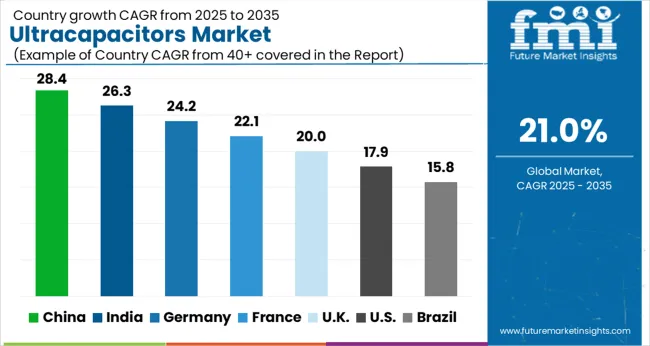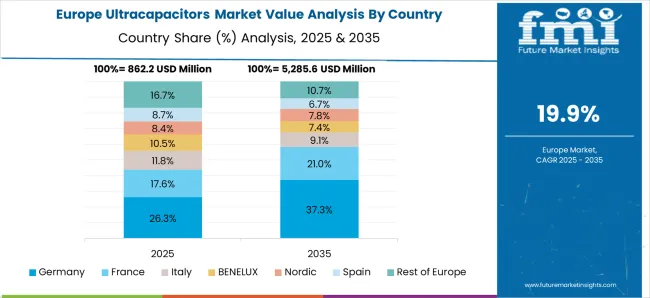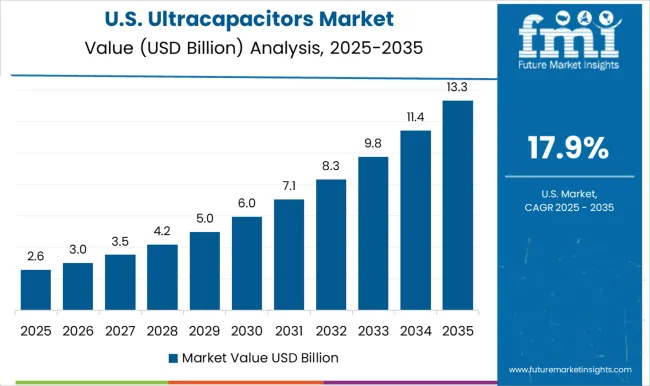The ultracapacitors market is estimated to be valued at USD 4.0 billion in 2025 and is projected to reach USD 26.6 billion by 2035, registering a compound annual growth rate (CAGR) of 21.0% over the forecast period.
This rapid growth, driven by a CAGR of 21%, is fueled by increasing demand for energy storage systems in electric vehicles (EVs), renewable energy integration, and industrial applications. In the first five years (2025–2030), the market is expected to expand from USD 4 billion to USD 10.3 billion, adding USD 6.3 billion, which accounts for 27.9% of the total incremental growth, with a 5-year multiplier of 2.58x. This early-phase growth is driven by advancements in ultracapacitor technology and its growing importance in high-power, rapid charge-discharge applications. The second phase (2030–2035) will contribute USD 16.3 billion, representing 72.1% of the total growth, driven by broader adoption across industries such as transportation, electronics, and grid energy storage.
Annual increments will rise from USD 1.6 billion in early years to USD 3.8 billion by 2035, signaling accelerated adoption due to continuous improvements in ultracapacitor efficiency, energy density, and cost reductions. Manufacturers focusing on scalability, sustainability, and integration with other energy systems will capture the largest share of this USD 22.6 billion opportunity.
| Metric | Value |
|---|---|
| Ultracapacitors Market Estimated Value in (2025 E) | USD 4.0 billion |
| Ultracapacitors Market Forecast Value in (2035 F) | USD 26.6 billion |
| Forecast CAGR (2025 to 2035) | 21.0% |
The ultracapacitors market is advancing rapidly due to growing demand for energy storage systems that offer high power density, fast charging capability, and long operational life. The shift toward electrification in transportation, industrial automation, and renewable energy integration is fueling the adoption of ultracapacitors as complementary systems to traditional batteries.
Technological developments in electrode materials, particularly graphene and carbon nanotubes, are enhancing the efficiency and capacity of ultracapacitors while maintaining compact form factors. Additionally, the global emphasis on carbon reduction and improved energy efficiency has encouraged industries to transition toward hybrid energy storage technologies.
The ability of ultracapacitors to perform in extreme temperatures and deliver consistent power output has further widened their applicability across sectors such as automotive, aerospace, and smart grid infrastructure. As industries prioritize durability, rapid energy discharge, and environmental sustainability, the market outlook for ultracapacitors remains highly optimistic.
The ultracapacitors market is segmented by type, application, end user, and geographic regions. By type, the market is divided into double-layered capacitors, pseudocapacitors, and hybrid capacitors. In terms of application, the ultracapacitors market is classified into aerospace & defense, automotive & transportation, consumer electronics, energy & utilities, industrial, and others. Based on end user, the market is segmented into Original Equipment Manufacturers (OEMs), aftermarket, and system integrators. Regionally, the ultracapacitors industry is classified into North America, Latin America, Western Europe, Eastern Europe, Balkan & Baltic Countries, Russia & Belarus, Central Asia, East Asia, South Asia & Pacific, and the Middle East & Africa.
The double layered capacitors segment is anticipated to account for 53.60% of total market revenue by 2025 within the type category, making it the most dominant segment. This growth is attributed to their proven capability in delivering high energy efficiency, rapid charge discharge cycles, and extended operational life.
These capacitors are particularly valued for applications that require frequent energy bursts and regenerative braking, such as in electric vehicles and industrial equipment. Their relatively simple construction and mature manufacturing processes contribute to cost effectiveness and scalability.
As energy storage becomes increasingly critical in next generation power systems, double layered capacitors continue to gain widespread preference due to their reliability, safety profile, and long cycle life.
The aerospace and defense segment is projected to hold 42.70% of total market revenue by 2025 under the application category, emerging as the leading application segment. The demand is driven by the need for robust, lightweight, and high performance energy storage solutions capable of operating under extreme conditions.
Ultracapacitors are being increasingly utilized in power backup systems, radar systems, avionics, and other mission critical applications where quick energy deployment is essential. Their resistance to temperature fluctuations and mechanical stress has made them suitable for defense electronics and aerospace control systems.
Strategic defense modernization initiatives and increased investment in advanced aircraft technologies are further supporting segment growth, positioning aerospace and defense as a major contributor to market expansion.
The original equipment manufacturers segment is expected to contribute 48.10% of overall market revenue by 2025 in the end user category, establishing its dominance. This leadership is driven by OEMs integrating ultracapacitors into their products to meet the growing performance expectations of industrial, transportation, and energy sectors.
OEMs are leveraging ultracapacitors for their rapid responsiveness, longevity, and compact design, which help in enhancing the overall functionality and durability of end products. With regulatory focus increasing on sustainable and energy efficient manufacturing practices, OEMs are aligning their product designs accordingly.
Their ability to control the design process and implement innovation at scale has placed them at the forefront of ultracapacitor adoption across diversified use cases.
The ultracapacitors market is driven by increasing demand for energy storage solutions in various sectors, particularly electric vehicles and renewable energy systems. Opportunities in hybrid energy storage systems are reshaping the market, while challenges like high costs and limited adoption in certain regions remain. By 2025, overcoming these obstacles through cost-effective solutions and infrastructure development will be key to ensuring the continued growth and adoption of ultracapacitors in energy storage applications.
The ultracapacitors market is experiencing growth due to the increasing demand for energy storage solutions across various sectors, including automotive, industrial, and consumer electronics. Ultracapacitors are widely used for energy storage and quick power delivery, especially in electric vehicles, renewable energy systems, and mobile devices. These devices offer advantages such as faster charging times, longer lifespan, and high power density. By 2025, the ultracapacitors market will continue to grow, driven by the increasing need for efficient and reliable energy storage in these sectors.
Opportunities in the ultracapacitors market are growing with the rising adoption of electric vehicles (EVs) and renewable energy systems. In EVs, ultracapacitors are used for regenerative braking and to provide additional power during acceleration, complementing traditional batteries. Similarly, in renewable energy systems like wind and solar, ultracapacitors help in stabilizing energy supply and improving grid efficiency. By 2025, the increased penetration of EVs and renewable energy projects will offer significant growth opportunities for ultracapacitors, driving market demand.
Emerging trends in the ultracapacitors market include the growing adoption of hybrid energy storage systems. These systems combine ultracapacitors with traditional batteries to optimize energy storage and delivery. Ultracapacitors offer rapid charging and discharging, while batteries provide long-term energy storage. This hybrid approach is gaining traction in electric vehicles, renewable energy storage, and industrial applications, offering more efficient and reliable solutions. By 2025, hybrid energy storage systems will continue to gain popularity as industries seek to maximize energy efficiency and minimize costs.
Despite growth, challenges such as high costs and limited adoption in certain regions persist in the ultracapacitors market. The initial cost of ultracapacitors is higher than traditional batteries, limiting their widespread adoption, especially in cost-sensitive applications. Additionally, some regions may lack the infrastructure or incentives to promote ultracapacitors in industries like automotive or renewable energy. By 2025, addressing these challenges through technological improvements and cost reduction strategies will be essential for making ultracapacitors more accessible and affordable across various industries.

The global ultracapacitors market is projected to grow at a 21% CAGR from 2025 to 2035. China leads with a growth rate of 28.4%, followed by India at 26.3%, and France at 22.1%. The United Kingdom records a growth rate of 20%, while the United States shows the slowest growth at 17.9%. These varying growth rates are driven by increasing demand for energy storage solutions, the rise of electric vehicles (EVs), and growing investments in renewable energy and smart grid technologies. Emerging markets like China and India are experiencing higher growth due to rapid industrialization, government incentives for clean energy technologies, and increasing adoption of electric mobility, while more mature markets like the USA and the UK see steady growth driven by advancements in energy storage systems, environmental regulations, and the rise of green technologies. This report includes insights on 40+ countries; the top markets are shown here for reference.
The ultracapacitors market in China is growing rapidly, with a projected CAGR of 28.4%. China’s strong focus on electric mobility, renewable energy integration, and energy storage technologies is driving the demand for ultracapacitors. The country’s growing investments in electric vehicle infrastructure, coupled with government incentives for clean energy solutions, continue to fuel the market growth. Additionally, China’s focus on grid modernization, energy-efficient solutions, and advancements in industrial applications, such as robotics and automation, further accelerates the adoption of ultracapacitors. As China continues to lead in clean energy adoption and sustainable technologies, the demand for ultracapacitors in commercial and industrial applications is expected to rise significantly.
The ultracapacitors market in India is projected to grow at a CAGR of 26.3%. India’s rapidly expanding electric vehicle market, growing investments in renewable energy projects, and increasing focus on energy storage systems are driving demand for ultracapacitors. The country’s push for reducing carbon emissions, combined with government incentives for clean energy solutions, further accelerates market growth. Additionally, India’s growing adoption of smart grid technologies and its emphasis on energy-efficient solutions in various sectors, including industrial automation, telecommunications, and electric mobility, is boosting the demand for ultracapacitors. The rise of electric vehicles and battery storage technologies continues to support the market’s expansion.

The ultracapacitors market in France is projected to grow at a CAGR of 22.1%. France’s growing demand for energy storage solutions, coupled with its focus on reducing carbon emissions and enhancing energy efficiency, is driving steady market growth. The country’s strong regulatory support for electric mobility, renewable energy projects, and sustainable infrastructure is contributing to the increasing adoption of ultracapacitors. France’s ongoing transition to green energy, along with investments in electric vehicle infrastructure and grid modernization, further supports the demand for ultracapacitors in both commercial and industrial applications. The country’s strong emphasis on sustainability and energy transition continues to boost market adoption.
The ultracapacitors market in the United Kingdom is projected to grow at a CAGR of 20%. The UK’s commitment to sustainability, coupled with rising demand for energy-efficient technologies and clean energy solutions, is driving steady growth in the market. The country’s growing focus on electric mobility, battery storage technologies, and renewable energy projects continues to accelerate the demand for ultracapacitors. Additionally, the UK’s emphasis on reducing carbon emissions and advancing smart grid technologies contributes to the growing adoption of ultracapacitors. The government’s strong support for green energy initiatives and the rise of energy storage systems in various industries further support market expansion.

The ultracapacitors market in the United States is expected to grow at a CAGR of 17.9%. The USA market is driven by the increasing adoption of electric vehicles, investments in renewable energy projects, and the need for efficient energy storage solutions. The growing focus on sustainability and carbon reduction policies is pushing for advanced energy storage technologies like ultracapacitors. Additionally, the USA market benefits from strong government incentives for clean energy adoption, grid modernization, and the integration of ultracapacitors into various commercial and industrial applications. The rise in electric mobility and advancements in smart grid technologies continue to drive the adoption of ultracapacitors.
The ultracapacitors market is dominated by Maxwell Technologies Inc., which leads with its innovative ultracapacitor solutions designed to deliver high power density and rapid charge/discharge capabilities for various applications, including automotive, industrial, and renewable energy systems. Maxwell’s dominance is supported by its advanced technology, strong partnerships with leading companies, and its focus on providing energy-efficient solutions that improve performance and reduce operational costs. Key players such as AVX Corporation, KEMET Corporation (YAGEO Group), and Panasonic Corporation maintain significant market shares by offering high-performance ultracapacitors used in a wide range of energy storage applications. These companies focus on enhancing energy density, extending lifespan, and reducing energy losses in power systems.
Emerging players like Skeleton Technologies and Tesla, Inc. are expanding their market presence by offering specialized ultracapacitor products designed for niche applications, such as electric vehicles, power backup systems, and grid stabilization. Their strategies include improving material efficiency, increasing energy storage capacity, and focusing on reducing the cost of manufacturing. Market growth is driven by the rising demand for energy storage systems, the shift toward electric vehicles, and the increasing need for fast-charging solutions in various industries. Innovations in graphene-based capacitors, hybrid energy storage systems, and integration with renewable energy sources are expected to continue shaping competitive dynamics and fuel further growth in the global ultracapacitors market.
Dollar sales by capacitor type and application, demand dynamics across automotive, energy storage, and industrial sectors, regional trends in ultracapacitor adoption, innovation in energy density and charge-discharge efficiency, impact of regulatory standards on safety and performance, and emerging use cases in electric vehicles and renewable energy systems.
| Item | Value |
|---|---|
| Quantitative Units | USD 4.0 Billion |
| Type | Double-layered capacitors, Pseudocapacitors, and Hybrid capacitors |
| Application | Aerospace & defense, Automotive & transportation, Consumer electronics, Energy & utilities, Industrial, and Others |
| End User | Original Equipment Manufacturers (OEMs), Aftermarket, and System integrators |
| Regions Covered | North America, Europe, Asia-Pacific, Latin America, Middle East & Africa |
| Country Covered | United States, Canada, Germany, France, United Kingdom, China, Japan, India, Brazil, South Africa |
| Key Companies Profiled | AVX Corporation, KEMET Corporation (YAGEO Group), Maxwell Technologies Inc., NEC Corporation, Panasonic Corporation, Skeleton Technologies, and Tesla, Inc. |
| Additional Attributes | Dollar sales by capacitor type and application, demand dynamics across automotive, energy storage, and industrial sectors, regional trends in ultracapacitor adoption, innovation in energy density and charge-discharge efficiency, impact of regulatory standards on safety and performance, and emerging use cases in electric vehicles and renewable energy systems. |
The global ultracapacitors market is estimated to be valued at USD 4.0 billion in 2025.
The market size for the ultracapacitors market is projected to reach USD 26.6 billion by 2035.
The ultracapacitors market is expected to grow at a 21.0% CAGR between 2025 and 2035.
The key product types in ultracapacitors market are double-layered capacitors, pseudocapacitors and hybrid capacitors.
In terms of application, aerospace & defense segment to command 42.7% share in the ultracapacitors market in 2025.






Full Research Suite comprises of:
Market outlook & trends analysis
Interviews & case studies
Strategic recommendations
Vendor profiles & capabilities analysis
5-year forecasts
8 regions and 60+ country-level data splits
Market segment data splits
12 months of continuous data updates
DELIVERED AS:
PDF EXCEL ONLINE

Thank you!
You will receive an email from our Business Development Manager. Please be sure to check your SPAM/JUNK folder too.
Chat With
MaRIA